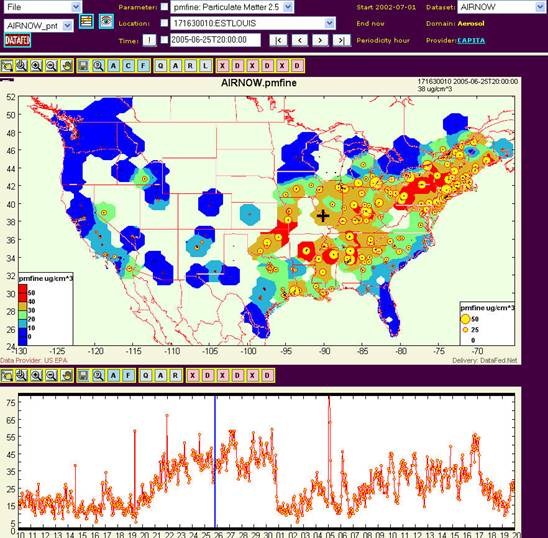Difference between revisions of "NSF Air Quality Observatory Proposal"
| Line 1: | Line 1: | ||
| + | This interactive wiki website was set up to facilitate the preparation of a NSF proposal for an Air Quality Observatory (AQO) prototype. The proposal is prepared using an open collaborative approach facilitated by this interactive wiki-based website where each participant can add, edit, or comment on any content. | ||
| + | |||
__FORCETOC__ {{template:Backlinks}} | __FORCETOC__ {{template:Backlinks}} | ||
Revision as of 23:02, January 15, 2006
This interactive wiki website was set up to facilitate the preparation of a NSF proposal for an Air Quality Observatory (AQO) prototype. The proposal is prepared using an open collaborative approach facilitated by this interactive wiki-based website where each participant can add, edit, or comment on any content.
| Links to: Air Quality Cluster > AQO Proposal Main Page > Proposal | Proposal Discussion| NSF Solicitation | NSF Solicitation Discussion | People |
People
Resources
NSF Proposal Outline 060110 Rhusar 17:45, 10 January 2006 (EST)
Background
Environmental Observatories: Environmental observatories, EO, are spatially extended, terrestrial, atmospheric and aquatic observing systems. EOs will use emerging sensor and networking technologies and deliver an extended range, type and quality of data to environmental researchers. The effectiveness of these observatories will hinge on broad availability of data and analysis tools and ease of data and tools, discovery and use. Environmental systems research requires interdisciplinary approaches and access to multi-disciplinary datasets. A particularly pressing need is the combination of data from different observing systems. The community has identified many remaining issues on how to construct the cyberinfrastructure for environmental observatories.
Example Challenges: Integrating multiple, existing information infrastructures in different environmental research disciplines. Bridging the semantics of multiple disciplines within environmental research. Extend the resources for orchestration by workflow tools; assist users in developing complex, multi-stage processing tasks. Support event-detection/triggered-responses in real-time data streams. Enabling the creation of user-configurable virtual observatories that bring together sensors from different observing systems.
Additional NSF Guidance: Focus on prototype development, viability, utility demo; not on longer operation/maintenance. Involve professionals versed in IT and Environmental Research; provide training opportunities. Developed software to be ready for reuse: make it robust, documented, disseminated.
NSF Requirements:
- Team members: info. scientists and env. researchers from ecology, ocean, atmospheric science, env. eng.
- Develop & deploy a prototype observatory as a component of cyberinfrastructure
- Identify information infrastructure technology IIT issues and how they EO will be addressing it in the project
- Identify environmental research questions and demonstrate the IIT benefits through a prototype
- Demonstrate the utility of the prototype to outside users; attract and include general users
- Leverage existing cyberinfrastructure developments, e.g. ITR, NMI or SEIII programs
- Identify IT gaps and how it will be filled in the prototype observatory
- Pursue end-to-end approach to a component of cyberinfrastructure
- Advance the technological capabilities of the environmental research community
- Use of existing or expected data streams/sets
- Leads to a flexible prototype, amenable to extension as technology evolves
- Project should not create new data or models; should not overlap with existing projects
Project Summary - Early Draft Example Challenges: Integrating multiple, existing information infrastructures in different environmental research disciplines. Bridging the semantics of multiple disciplines within environmental research. Extend the resources for orchestration by workflow tools; assist users in developing complex, multi-stage processing tasks. Support event-detection/triggered-responses in real-time data streams. Enabling the creation of user-configurable virtual observatories that bring together sensors from different observing systems.
Additional NSF Guidance: Focus on prototype development, viability, utility demo; not on longer operation/maintenance. Involve professionals versed in IT and Environmental Research; provide training opportunities. Developed software to be ready for reuse: make it robust, documented, disseminated.
